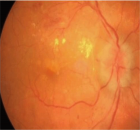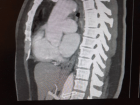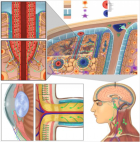Abstract
Review Article
A proposed mechanism to explain increases in intracranial pressure: The concept of cerebral artery wedge pressure
DR Hamilton*, A Mitha, MG Hamilton and JV Tyberg
Published: 08 January, 2020 | Volume 5 - Issue 1 | Pages: 001-003
We hypothesize that, with elevated cerebral spinal fluid (CSF) pressure, cerebral micro-vascular obstruction and congestion may occur despite (subdural) large-vein pressures being normal. Smaller veins emptying into these larger, dura-enveloped veins are not immune to the compressive effects of elevated CSF pressure and a “Starling Resistor” mechanism might explain why elevated CSF pressures collapse these smaller veins. This small cerebral venous starling resistor compression mechanism may be the final common pathway for many patients suffering from increased CSF pressures and might also be an important contributor to impaired focal venous drainage presenting as a headache with normal venous sinus pressures.
Read Full Article HTML DOI: 10.29328/journal.jccm.1001076 Cite this Article Read Full Article PDF
Keywords:
Coronary artery bypass grafting; Longitudinal strain; Right ventricle; Circumferential strain
References
- Friedman DI. Cerebral venous pressure, intra-abdominal pressure, and dural venous sinus stenting in idiopathic intracranial hypertension. J Neuroophthalmol. 2006; 26: 61-64. PubMed: https://www.ncbi.nlm.nih.gov/pubmed/16518170
- Albuquerque FC, Dashti SR, Hu YC, Newman CB, Teleb M, et al. Intracranial venous sinus stenting for benign intracranial hypertension: clinical indications, technique, and preliminary results. World neurosurg. 2011; 75: 648-652. PubMed: https://www.ncbi.nlm.nih.gov/pubmed/21704931
- Johnston I, Paterson A. Benign intracranial hypertension. II. CSF pressure and circulation. Brain. 1974; 97: 301-12. PubMed: https://www.ncbi.nlm.nih.gov/pubmed/4434179
- King JO, Mitchell PJ, Thomson KR, Tress BM. Cerebral venography and manometry in idiopathic intracranial hypertension. Neurology. 1995; 45: 2224-2228. PubMed: https://www.ncbi.nlm.nih.gov/pubmed/8848197
- Magder S. Starling resistor versus compliance. Which explains the zero-flow pressure of a dynamic arterial pressure-flow relation? Circulation res. 1990; 67: 209-220. PubMed: https://www.ncbi.nlm.nih.gov/pubmed/2364491
- Swan HJ, Ganz W, Forrester J, Marcus H, Diamond G, et al. Catheterization of the heart in man with use of a flow-directed balloon-tipped catheter. N Engl J Med. 1970; 283: 447-451. PubMed: https://www.ncbi.nlm.nih.gov/pubmed/5434111
- Kubiak GM, Ciarka A, Biniecka M, Ceranowicz P. Right Heart Catheterization-Background, Physiological Basics, and Clinical Implications. J Clin Med. 2019; 8. E1331. PubMed: https://www.ncbi.nlm.nih.gov/pubmed/31466390
- Daniel PMD, JD, Prichard MM. Studies of the Carotid Rete and Its Associated Arteries. Phil Trans Roy Soc London. 1953; 237: 173-208. PubMed:
- Wang H, Kim M, Normoyle KP, Llano D. Thermal Regulation of the Brain-An Anatomical and Physiological Review for Clinical Neuroscientists. Front Neurosci. 2015; 9: 528. PubMed: https://www.ncbi.nlm.nih.gov/pubmed/26834552
Figures:

Figure 1
Similar Articles
-
Acute viral myocarditis due to Influenza H3N2 infection resembling an acute coronary syndrome: A case reportCarlos Jesus Rodriguez-Zuñiga*,Leonel Martínez-Ramírez,Carlos Alberto Guizar-Sanchez,Mauricio Quetzal Trejo-Mondragon,Nilda Espinola-Zavaleta. Acute viral myocarditis due to Influenza H3N2 infection resembling an acute coronary syndrome: A case report. . 2019 doi: 10.29328/journal.jccm.1001039; 4: 041-042
-
Single Trans apical access for double aortic and mitral valves-in-valves procedures with high risk of thrombus embolismJulien Adjedj*,Mathias Kirsch,Anna Nowacka ,Olivier Muller. Single Trans apical access for double aortic and mitral valves-in-valves procedures with high risk of thrombus embolism. . 2019 doi: 10.29328/journal.jccm.1001042; 4: 071-072
-
Only low intensity of aerobic exercise improves respiratory compliance in pulmonary hypertensive ratsKatya Rigatto*,Denielli Da SG Bós,Renata Fernandes,Rodrigo B Jaenisch,Pedro Dal Lago. Only low intensity of aerobic exercise improves respiratory compliance in pulmonary hypertensive rats. . 2019 doi: 10.29328/journal.jccm.1001069; 4: 205-209
-
Evaluation of the effect of coronary artery bypass grafting on the right ventricular function using speckle tracking echocardiographyMahmoud Shawky Abdelmoneum,Neama Ali Elmeligy,Elsayed Abdelkhalek Eldarky,Mohamad Mahmoud Mohamad*. Evaluation of the effect of coronary artery bypass grafting on the right ventricular function using speckle tracking echocardiography. . 2019 doi: 10.29328/journal.jccm.1001075; 4: 236-241
-
Influence of Histidine on the contractility and adrenaline inotropic effect in the experiments with myocardium of right ventricular of Non pregnant and Pregnant RatsVictor Tsirkin*,Alexander Nozdrachev,Julia Korotaeva,Grigorij Khodyrev. Influence of Histidine on the contractility and adrenaline inotropic effect in the experiments with myocardium of right ventricular of Non pregnant and Pregnant Rats . . 2018 doi: 10.29328/journal.jccm.1001030; 3: 084-103
-
RV Function by cardiac magnetic resonance and its relationship to RV longitudinal strain and neutrophil/lymphocyte ratio in patients with acute inferior ST-segment elevation myocardial infarction undergoing primary percutaneous interventionSalma Taha*,Shrouk Kelany Ali,Fabrizio D’Ascenzo,Hosam Hasan-Ali,Yousra Ghzally#,Mohamed Abdel Ghany. RV Function by cardiac magnetic resonance and its relationship to RV longitudinal strain and neutrophil/lymphocyte ratio in patients with acute inferior ST-segment elevation myocardial infarction undergoing primary percutaneous intervention. . 2021 doi: 10.29328/journal.jccm.1001120; 6: 059-065
-
Does global longitudinal strain improve stratification risk in heart failure with preserved ejection fraction?Assia Haddad*,Mohamed Karim Guerchani,Nadia Ould Bessi,Dalila Djermane,Omar Ait Mokhtar,Hakim Himeur,Salim Benkhedda. Does global longitudinal strain improve stratification risk in heart failure with preserved ejection fraction?. . 2022 doi: 10.29328/journal.jccm.1001137; 7: 074-080
-
Myocardial fibrosis in aortic stenosis: comparison between clinical data, laboratory, echocardiography, and cardiac magnetic resonanceGiuseppe Tosto, Giulia Passaniti, Fortunata Alessandra Gibiino, Wanda Deste*, Antonino Indelicato, Tito Torrisi, Giuseppe Bottaro, Maria Teresa Cannizzaro, Corrado Tamburino. Myocardial fibrosis in aortic stenosis: comparison between clinical data, laboratory, echocardiography, and cardiac magnetic resonance. . 2023 doi: 10.29328/journal.jccm.1001153; 8: 051-058
-
Value of Speckle Tracking Echocardiography in Prediction of Left Ventricular Reverse Remodeling in Patients with Chronic total Occlusion Undergoing Percutaneous Coronary InterventionsGehan Magdy*, Sahar Hamdy Azab, Yasmin Ali Esmail, Mohamed Khalid Elfaky. Value of Speckle Tracking Echocardiography in Prediction of Left Ventricular Reverse Remodeling in Patients with Chronic total Occlusion Undergoing Percutaneous Coronary Interventions. . 2023 doi: 10.29328/journal.jccm.1001170; 8: 164-170
Recently Viewed
-
Gentian Violet Modulates Cytokines Levels in Mice Spleen toward an Anti-inflammatory ProfileSalam Jbeili, Mohamad Rima, Abdul Rahman Annous, Abdo Ibrahim Berro, Ziad Fajloun, Marc Karam*. Gentian Violet Modulates Cytokines Levels in Mice Spleen toward an Anti-inflammatory Profile. Arch Asthma Allergy Immunol. 2024: doi: 10.29328/journal.aaai.1001034; 8: 001-006
-
Current Situation of Municipal Solid Waste Management in the Urban and Peri-urban of Phnom Penh, CambodiaYim Mongtoeun*, Lim Sousan, Hoy Sereivathanak Reasey, Timothy John A Pasicolan, Paulo N Pasicolan. Current Situation of Municipal Solid Waste Management in the Urban and Peri-urban of Phnom Penh, Cambodia. Ann Civil Environ Eng. 2023: doi: 10.29328/journal.acee.1001057; 7: 067-072
-
Studies on the Influence of Charge Inducer and it’s Combination with P-gp Inhibitor to Improve the Oral Bioavailability of Nimodipine via Submicron Lipid EmulsionsSara Fathima,Veerabrahma Kishan*. Studies on the Influence of Charge Inducer and it’s Combination with P-gp Inhibitor to Improve the Oral Bioavailability of Nimodipine via Submicron Lipid Emulsions. Arch Pharm Pharma Sci. 2023: doi: 10.29328/journal.apps.1001046; 7: 074-082
-
Update on the Clinical Applications of Mesenchymal Stem CellsKhalid Ahmed Al-Anazi*. Update on the Clinical Applications of Mesenchymal Stem Cells. J Stem Cell Ther Transplant. 2023: doi: 10.29328/journal.jsctt.1001034; 7: 043-064
-
An Update of Bronchiolitis - A ReviewMd Atiar Rahman*. An Update of Bronchiolitis - A Review. Arch Case Rep. 2023: doi: 10.29328/journal.acr.1001083; 7: 077-079
Most Viewed
-
Evaluation of Biostimulants Based on Recovered Protein Hydrolysates from Animal By-products as Plant Growth EnhancersH Pérez-Aguilar*, M Lacruz-Asaro, F Arán-Ais. Evaluation of Biostimulants Based on Recovered Protein Hydrolysates from Animal By-products as Plant Growth Enhancers. J Plant Sci Phytopathol. 2023 doi: 10.29328/journal.jpsp.1001104; 7: 042-047
-
Feasibility study of magnetic sensing for detecting single-neuron action potentialsDenis Tonini,Kai Wu,Renata Saha,Jian-Ping Wang*. Feasibility study of magnetic sensing for detecting single-neuron action potentials. Ann Biomed Sci Eng. 2022 doi: 10.29328/journal.abse.1001018; 6: 019-029
-
Sinonasal Myxoma Extending into the Orbit in a 4-Year Old: A Case PresentationJulian A Purrinos*, Ramzi Younis. Sinonasal Myxoma Extending into the Orbit in a 4-Year Old: A Case Presentation. Arch Case Rep. 2024 doi: 10.29328/journal.acr.1001099; 8: 075-077
-
Pediatric Dysgerminoma: Unveiling a Rare Ovarian TumorFaten Limaiem*, Khalil Saffar, Ahmed Halouani. Pediatric Dysgerminoma: Unveiling a Rare Ovarian Tumor. Arch Case Rep. 2024 doi: 10.29328/journal.acr.1001087; 8: 010-013
-
Physical activity can change the physiological and psychological circumstances during COVID-19 pandemic: A narrative reviewKhashayar Maroufi*. Physical activity can change the physiological and psychological circumstances during COVID-19 pandemic: A narrative review. J Sports Med Ther. 2021 doi: 10.29328/journal.jsmt.1001051; 6: 001-007

HSPI: We're glad you're here. Please click "create a new Query" if you are a new visitor to our website and need further information from us.
If you are already a member of our network and need to keep track of any developments regarding a question you have already submitted, click "take me to my Query."

























































































































































